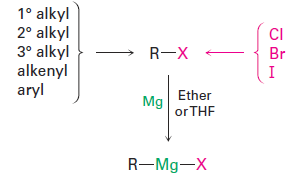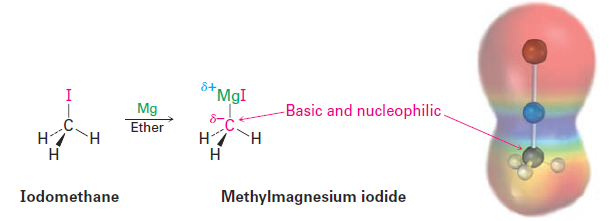
Reactions of Alkyl Halides: Grignard Reagents
 المؤلف:
John McMurry
المؤلف:
John McMurry
 المصدر:
Organic Chemistry
المصدر:
Organic Chemistry
 الجزء والصفحة:
9th. p 298
الجزء والصفحة:
9th. p 298
 28-5-2017
28-5-2017
 2854
2854
Reactions of Alkyl Halides: Grignard Reagents
Alkyl halides, RX, react with magnesium metal in ether or tetrahydrofuran (THF) solvent to yield alkylmagnesium halides, RMgX. The products, called Grignard reagents (RMgX) after their discoverer, Victor Grignard, are examples of organometallic compounds because they contain a carbon–metal bond. In addition to alkyl halides, Grignard reagents can also be made from alkenyl (vinylic) and aryl (aromatic) halides. The halogen can be Cl, Br, or I, although chlorides are less reactive than bromides and iodides. Organofluorides rarely react with magnesium.

As you might expect from the discussion of electronegativity and bond , polarity the carbon–magnesium bond is polarized, making the carbon atom of Grignard reagents both nucleophilic and basic. An electrostatic potential map of methylmagnesium iodide, for instance, indicates the electron-rich (red) character of the carbon bonded to magnesium.

A Grignard reagent is formally the magnesium salt, R3C-+MgX, of a carbon acid, R3C-O-H, and is thus a carbon anion, or carbanion. But because hydrocarbons are such weak acids, with pKa’s in the range 44 to 60 carbon anions are very strong bases. Grignard reagents must therefore be protected from atmospheric moisture to prevent their being protonated and destroyed in acid–base reactions: R-O Mg-O-X + H2O → R-O-H + H-O-Mg-O-X.

 الاكثر قراءة في الجدول الدوري وخواص العناصر
الاكثر قراءة في الجدول الدوري وخواص العناصر
 اخر الاخبار
اخر الاخبار
اخبار العتبة العباسية المقدسة


